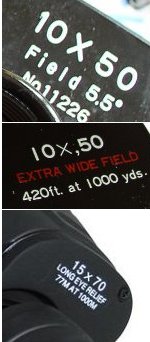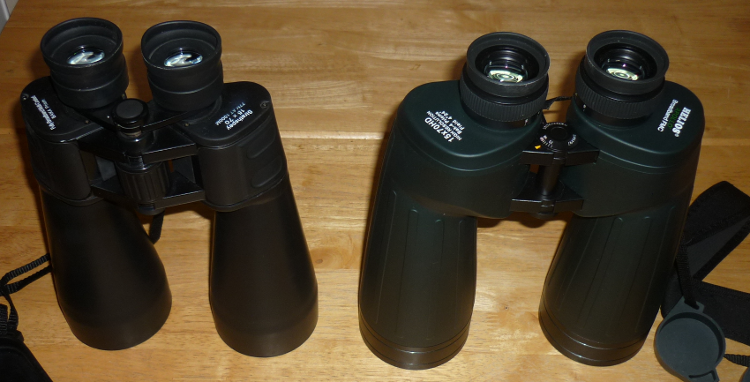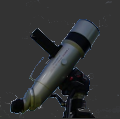Choosing a First Binocular for Astronomy
If you have any comments, suggestions or requests for this page, please tell me.
I strongly recommend that you read this page in conjunction with Binocular Basics.
1. What makes a Good First Binocular?
2. Realistic Expectations and Quality
3. 10×50
4. 15×70
5. Best Buys
5. Links
1. What makes a Good First Binocular?

Binoculars are described by two numbers, magnification and nominal aperture, for example, a 10×50 binocular has a magnification of 10 and an aperture of 50mm. (See here
for more information and explanation).
A larger aperture lets more light into the instrument, enabling you to see fainter objects. You should therefore consider the greatest practicable aperture (more on "practicable" later). It also theoretically increases the resolution of the binocular but, since the binocular will not be used at a magnification anything like enough to achieve maximum resolution, this is largely irrelevant.
The magnification is important for two reasons. Firstly, it enables you to make out detail that you would not normally be able to see. Secondly, increasing the magnification darkens the sky background, improving the contrast of some objects. Unless you observe under exceptionally dark skies, you should therefore consider the greatest practicable magnification.
So, what do we mean by "practicable"? If we increase the aperture, we increase the physical size and, more importantly, the weight, of the binocular (if we double the aperture of a lens, its weight will increase by approximately eight times). This makes it more difficult to hold steadily for long periods. If we increase the magnification, we magnify our "shake"; this makes it more difficult to observe satisfactorily and actually makes some objects invisible. We can ameliorate some of these effects by holding the binocular in a more effective manner, or by mounting it.
It varies from individual to individual, but a general rule of thumb is that almost all adults can comfortably hand-hold an 8×40 for sustained periods, for many a 10×50 is the largest size for sustained hand-held observing, and that a 15×70 is hand-holdable for short periods. The shake you get when hand-holding a binocular is not usually obtrusive on large objects (e.g. Orion Nebula, Andromeda Galaxy), but is infuriating on double stars that test the binocular (e.g. Albireo or δ Cephei for a 10×50)
The question of "Porro prism" or "roof prism" inevitably arises (see here for more information). Briefly, a roof prism needs to be made to a much higher optical standard than does a Porro prism, you will therefore in general get the equivalent optical quality for less money if you opt for a Porro prism binocular.

Left: Porro-Prism, Right: Roof Prism
Other factors that you must consider are general optical and mechanical quality. Nobody ever complains that the quality of a piece of observing kit is too high! Once you become aware that your binocular is of a lesser quality, it becomes increasingly difficult to enjoy it. Do not be tempted with claims of exotic glass or coatings, in budget binoculars, much of it is marketing hype and there are much more important considerations for binocular choice, such as crispness of focus, flatness of field, edge distortion, chromatic aberration, build quality, smoothness of focus ... I could go on ... and on. The first binocular I ever used for astronomy, a 1960s or '70s vintage Zeiss 10×50, had BK7 prisms and single-layer coatings – overall it was optically and mechanically superior, and hence better suited to astronomy, than many of today's budget fully multi-coated efforts with BaK4 prisms.
In my opinion, the best choice for a first binocular for astronomy is a 10×50. I'll expand on "Why?"
below.
2. Realistic Expectations and Quality
Where binoculars are concerned, you tend to get what you pay for and, if something looks too good to be true, it probably is.
It is nowadays possible to obtain a 10×50 binocular for as little as £15 and a 15×70 binocular for around £50. These budget 15×70s, most of which are made by the Chinese manufacturer Kunming Optical (also known as United Optical and Binoculars China), are a remarkable achievement for the price, and have made this class of binocular available to many more people than was the case 20 years ago when you would have needed to pay ten times as much for a 70mm astronomical binocular (albeit of far better quality). However, these binoculars are over-represented in "how do I solve this problem?" type threads on astronomical forums. Think about it: a minimally decent astronomical eyepiece costs about £40. A binocular has two eyepieces, two objectives, two different focusing mechanisms, prisms and housing, and other bits of tubing: realistically, what sort of quality is it reasonable to expect for the cost of one and a quarter eyepieces (in the case of the 15×70)? Many people claim to be satisfied with these binoculars and undoubtedly some are. It is also the case that we find it psychologically difficult to admit to a poor choice, so we tend to fool ourselves — I have been as guilty of this self-deception as anyone else; it is a human trait.
But don't take my word for this quality, read what the
manufacturer says:
For years, the international markets are flooded with unbelievably low-price Chinese binoculars and some of the users have been complaining or bashing loudly about the quality control consistency of Chinese binoculars for a while. Actually, it's quite simple to improve the quality consistency: spending much more time in grinding and selecting glass, spending much more time in training the workers for assembling the binoculars, and spending much more time in the final quality check - then, a much better quality binocular will be made, however, at the trade-off of much higher production cost.

Two 15x70 Binoculars Left: Kunming BA1 (Budget) Right: Kunming BA8 (Premium)
This confirms a long-held suspicion that Kunming finds it more cost effective to let the customer do the quality control on these budget offerings. An unknowledgeable customer is more likely to accept a binocular of such poor quality that any self-respecting quality controller would have to reject, and the company only effectively pays for the quality control of rejected binoculars.
A common feature of these budget offerings is that they lose collimation very easily. A well-made binocular will hold collimation for decades unless it is severely abused (usually to the extent that the outer casing is dented or shows other signs of abuse); a high proportion of the budget binoculars reach the customer already out of collimation. Poor collimation may result in double images or, if it is of lesser severity, eye-strain that can lead to headaches and/or nausea.
It is therefore of utmost importance that you learn to evaluate a budget binocular if that is what you are considering. For this reason, I publish this guide to evaluating binoculars.
3. 10×50
In my opinion, the best value for money all-rounder is a Porro-prism 10×50 binocular of the best quality you can afford. The reasons for this are:
- It is hand-holdable by most people: a normal 8-year old can be taught how to hold it steadily.
- It is easily portable.
- It has uses outside astronomy, such as birding, racing, general daytime observing, etc.
- There are hundreds of astronomical objects that are possible to observe in a binocular of this size, and some (e.g. large open clusters like M45 or NGC 4755) that are arguably better in this size than any other.
- Even if you "progress" to a telescope as a main observing instrument, you will still find this binocular useful to "cast" around the sky, maybe as a sort of "pre-finder" to your main instrument.

A selection of inexpensive 10×50 Binoculars. From L-R:
Zenith: An old fashioned style. Available very cheaply second hand.
Swift Newport Mk2: A robust 1-piece body with wide-angle eyepieces.
Helios Naturesport: A modern, lightweight binocular; a good all-rounder.
Strathspey Marine: Very robust. Has individually focusing eyepieces, which is good for astronomy.
Some authorities recommend a 7×50 – There is a slight increase in brightness of extended objects (e.g. nebulae and galaxies), but this is matched by a corresponding increase in background sky brightness, so there is little real advantage except on perhaps half a dozen very large objects (e.g. M33, NGC 7000). However, it does have the advantage that it is easier to hold steadily. One thing to be aware of is that internal vignetting (common in budget binoculars) can reduce the effective aperture to around 42mm, so you may not get the full 50mm aperture.
With that last point in mind, if you are concerned about your ability to hold a 10×50 steadily, you may prefer to choose a 8×40 Porro prism, or a 8×42 or 10×42 roof prism, provided the stated aperture is correct.
You should also know that the prisms of many budget binoculars are very easy to dislodge, resulting in poor collimation. It is often possible to restore them to conditional alignment using the collimation screws; this may be a skill worth learning.
4. 15×70

The 15×70 is an increasingly popular choice, and the increased aperture over a 10x50 (nearly twice as much light throughput to the eye when compared to a 10×50) makes it attractive (but note that this is less than a magnitude of brightness!). The budget ones weigh around 1.3kg, and the good quality ones (such as the Helios Apollo) nearly twice this. You must therefore consider some form of support if you are going to use it for anything other than very short observations. This could range from the arm-rests on a picnic chair, through an upturned broom as a jury-rigged monopod, to a good parallelogram mount.
There are many brands of binocular in the budget class, many of which look cosmetically identical. Kunming permits the supplier to specify various options, so this outer similarity can, and often does, hide subtle differences such as coating quality, lens quality, prism coatings, eyepiece types, internal baffling and the degree of quality control. You should also be aware that internal vignetting (common in budget binoculars) can reduce the effective aperture to around 63mm, so this would reduce the light gathering advantage over a 10×50 to about 1 ½ times. The sensitivity of the prisms to accidental miscollimation (mentioned above) also applies here.
5. Best Buys
My intention in these pages is to enable you to make your own informed decisions. However, if you are interested in my opinion, you may find these suggestions to be useful.
If you are considering budget models, please note the caveats above relating to miscollimation and stopped-down apertures.
Around £50
- 8x40 Centre-Focus Porro: Olympus DPs-1.
A very good entry-level Porro-prism binocular that has been favourably compared with the legendary Swift Audubon. Good choice for those on a budget and for whom a 10x50 is too heavy. Further details at Amazon. - 10x50 Centre-Focus: Opticron Adventurer 10x50.
A good, tripod-mountable (with L-bracket), all-rounder. It does have the unjustly maligned (click here to learn why) BK7 prisms, but is surprisingly good both optically and mechanically, and is much better than a lot of other stuff at a similar price. Unlike many budget binoculars, it is not internally stopped down, so you get the full 50mm aperture. It represents very good value for money. Review here. Further details at First Light Optics. - 15x70 Centre-Focus Porro: Magnivision.
An entry-level 15x70 that is relatively inexpensive, but prone to miscollimation, so you will need to learn how to remedy this. Internally stopped to about 63mm. Details and reviews at Amazon UK.
Around £100
- 10x50 Centre-Focus Porro: Opticron Adventurer T WP 10x50.
If there is a better 10x50 for under £125, I’ve not seen it. Everything works as it should, the image in the sweet spot is extremely good, it has decent coatings, it is waterproof, it is lightweight and comfortable to use, the strap is good quality and comfortable, unusually for a budget binocular it is not significantly stopped down, and it will suit a wide range of faces. Review here. Details at First Light Optics. - 8x42 Roof: Opticron Oregon 4 LE 8x42 WP.
Excellent choice for someone who needs a good entry-level lightweight binocular that is very easy to hold steadily. It is nitrogen-filled and waterproof. Further details at First Light Optics.
- 10x42 Roof: Opticron Oregon 4 LE 10x42 WP.
A very good entry-level roof prism binocular, for those who prefer a little more magnification and contrast than the 8x42 version offers. It is waterproof and nitrogen-filled. Further details at First Light Optics.
- 10x50 Individual-Focus Porro: Strathspey Marine.
A very robust binocular. Nitrogen-filled to prevent internal fogging. Reasonably sharp, but this is at the expense of their being internally stopped to about 41mm. Details and reviews at Strathspey. - 15x70 Centre-Focus Porro: Opticron Oregon.
A good incarnation of the Kunming BA1 that represents good value for money. Although it looks cosmetically identical (apart from logos) to the Revelation version above, these binoculars are made to a different specification, although the caveat about losing collimation if bumped still applies. There is also a 11x70 version. Review here. Details at First Light Optics
Around £150
- 8x42 Centre-Focus Porro: Opticron Imagic TGA WP 8x42.
A lovely little binocular that gives excellent images. Very good optics, lightweight, click-stop twist-up eyecups, with easily enough eye relief to make it suitable for spectacle wearers. It has a very flat field of view. Very firm eyepiece bridge that does not rock in normal use. Review here. Further details at First Light Optics.
- 10x50 Centre-Focus Porro: Pentax SP 50mm WP.
This is the upgraded replacement for the PCF-WP II, which was a popular choice as an intermediate quality general-purpose binocular. Robust but light construction and nitrogen-filled to prevent internal fogging. Does not have a traditional eyepiece bridge, so does not suffer from bridge rocking. It has a lockable focus, which is very useful for astronomy. Very flat field of view. The control of stray light is superb. Remarkably good value for money. Review here. Details at First Light Optics. - 15x70 Individual-Focus Porro: Helios Stellar-II 70mm WP.
A very good entry-level individual focus 15x70 (also available as a 10.5x70). It is not internally stopped, so you get the full benefit of the 70mm objective lenses and it is a good half magnitude brighter than the budget 15x70s (above). They have sufficient eye relief to be used with specatacles and, being waterproof, will not suffer from ingress of dew. Review here. Details at First Light Optics.
Around £200
- 10x50 Individual-Focus Porro: William Optics.
An outstandingly good binocular for this price range. Very bright with a wide field of view. Details at First Light Optics.
The TS-Marine is the same binocular, and may be less expensive, depending on currency conversion rates. Details at Teleskop Service
Over £200
- 20x60 Centre-Focus Porro: Pentax SP 20x60 WP.
Robust but light construction and nitrogen-filled to prevent internal fogging. Does not have a traditional eyepiece bridge, so does not suffer from bridge rocking. It has a lockable focus, which is very useful for astronomy. Very flat field of view, and sharp across abut 95% of the field of view. Review here. Details at First Light Optics. - 10x50 Individual Focus Porro: Helios LightQuest 10x50.
Extremely good 10x50. Optical quality as good as the WO and TS binoculars (above), and they are a significant 300g lighter and have sufficient eye relief to be used by spectacle-wearers. Waterproof and nitrogen-filled to prevent dew ingress and internal fogging. Review here. Details at First Light Optics. - 15x70 Individual Focus Porro: Helios Apollo 15x70.
This is the Helios-branded version of the very popular United Optics BA8. Very robust construction and nitrogen-filled to prevent internal fogging. Eyepieces are threaded externally to accept 1.25-inch filters (eg UHC, [O-III], but this useful eyepiece design also means that most of the stated eye relief is unavailable, so spectacle wearers will not see the whole field of view. There are also 10.5x70 and larger versions available. Details at First Light Optics. - 15x70 Individual Focus Porro: Helios LightQuest 15x70.
Extremely good 15x70. Optical quality slightly better than the Apollo binocular (above), due to the higher focal-ratio objective lenses. They are a very significant 600g lighter than the Apollo and have sufficient eye relief to be used by spectacle-wearers. Waterproof and nitrogen-filled to prevent dew ingress and internal fogging. There are also 11x70 and larger versions available. Review here.Details at First Light Optics.
Mounting Hardware
There is much more comprehensive coverage of this at Mounting Binoculars for Astronomy (opens in new tab).
- Sturdy tripod adaptors that will fit a variety of binoculars with a mounting bush, including roof prisms, can be obtained from Amazon UK and Amazon USA.
- This hinge-clamp will enable the mounting of many Porro-prism binoculars (not roof prisms!) without a mounting bush.
- Trigger-grip ballheads can be obtained from Amazon UK (with tripod, but cheaper than buying the trigger-grip separately; you can use the tripod as a monopod) and Amazon USA. You will also need one of these adaptors unless your monopod/tripod has a 3⁄8" mounting screw.
 Do not be tempted by the "pistol grip" heads that look like this — they may be OK for photography, but they are extremely awkward to use for astronomy!
Do not be tempted by the "pistol grip" heads that look like this — they may be OK for photography, but they are extremely awkward to use for astronomy! - Paragon-Plus: A basic commerically available parallelogram that is good for binoculars up to about 2.3kg (5 lb) and usable up to about 3.5kg (7.5lb). It fits to a photographic tripod. They can be obtained from Amazon UK and Amazon USA.
Also available with a tripod (Amazon UK and Amazon USA.
5. Links
- Binocular Sky Reviews My reviews of binocular astronomy kit
- Cloudy Nights Binocular Reviews. See what other people think.
- Choosing Binoculars for Astronomy. Alan MacRobert's take on the subject (from Sky & Telescope)


